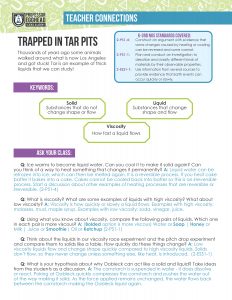A long, long time ago, when dinosaurs roamed the Earth, Tar Pits bubbled up from beneath the ground. Luckily, we don’t have to deal with those today (although there are still some in LA!) but we do have to deal with a variety of other Viscous Liquids. This week, let’s revisit the States of Matter, find out what the heck Oobleck is, and get a little messy in the process.
Keywords
- Solid
- Liquid
- Viscosity
- Non-Newtonian Fluid
- Pitch
materials list
- A piece of printer paper + tape (Or a Funnel)
- An Empty Cup covered with Tin foil
- ½ glass of Water
- ½ glass of Liquid Dish Soap
- ½ glass of Water/Dish Soap Mixture
- Small Bowl
- ½ cup of Corn Starch
- One more ¼ cup of Water
- A plastic Spatula (or your hands!)
- Optional: Trapped in Tar Worksheet
background
Matter exists in one of three forms –solid, liquid or gas. SOLIDS are firm and stable and do not change shape or flow. GASES change their shape and volume readily to fill whatever space is available. LIQUIDS flow from place to place and change shape although their volume does not change. The state of matter is usually dependent on its temperature.
This class will focus on different properties of liquids. One property is how fast a liquid flows, also called VISCOSITY. When a liquid flows very slowly it is more viscous and if it flows rapidly like water it is less viscous. The viscosity of a liquid depends on internal characteristics, like the complexity of the molecules that make up the substance. Water molecules are very simple, so they flow by each other easily and do not have much friction with each other. Simple molecules like water, will flow quickly and are not viscous. Molecules like those that make up corn syrup or sugar are more complex and have a lot of friction when they try to move by each other. This makes them slow down and the overall substance is more viscous.
In nature, we find a variety of different liquids. One of the most interesting is tar. TAR is a highly viscous liquid that is typically a byproduct of coal production, but can also form other organic matter breaking down. Tar only bubbles up to the earth’s surface in a few places on the planet. When it does, it can form very large pools called tar pits. Los Angeles is home to one of the world’s most famous of these, the La Brea Tar Pits. Some forms of tar are up to 230 billion times more viscous than water. There is an experiment running in which tar flows from a funnel, but because the tar is so viscous, only 9 drops have fallen since 1927 when the experiment was begun! In fact, it wasn’t until July 2013 that a drop of tar falling was actually captured on camera. That experiment is still being streamed today: Pitch Drop Livestream. In ancient times, animals inadvertently wandered into the pits and got stuck because the tar is so thick. Scientists have excavated thousands of fossils from the pits and learned incredible things about our prehistoric world - Tar Pit Video
The last property we’re going to talk about today is something that can happen when you mix certain solids and liquids together. For example, when cornstarch and water are combined together, they make a substance that scientists refer to as oobleck. When poured or stirred slowly, the oobleck flows like a liquid because the cornstarch particles can move freely. However, when pressure is applied, for instance by hitting the oobleck with a hammer, the cornstarch particles are forced together and the substance becomes so viscous that it acts like a solid. Once that quick force is no longer applied, the water is able to seep back between the cornstarch and act like a liquid again. If you had a giant pool of oobleck you could even run on the surface of it as long as you kept moving quickly. Liquids that change their viscosity when pressure is applied are called NON-NEWTONIAN FLUIDS. Oobleck is one of these fluids.
keywords
STATES OF MATTER: SOLIDS LIQUIDS, AND GASES
VISCOSITY: HOW FAST A LIQUID FLOWS
TAR: A VERY VISCOUS LIQUID THAT OOZES FROM THE GROUND (ALSO CALLED PITCH)
NON-NEWTONIAN FLUID: CHANGE VISCOSITY WHEN QUICK PRESSURE IS APPLIED
OOBLECK: A NON-NEWTONIAN FLUID MADE OF CORNSTARCH AND WATER
science standards
2-PS1-1 : Plan and conduct an investigation to describe and classify different kinds of materials by their observable properties.
2-ESS1-1 : Use information from several sources to provide evidence that Earth events can occur quickly or slowly.

